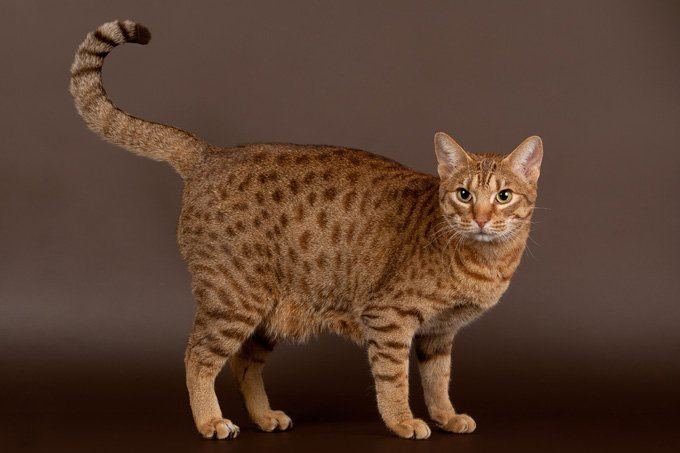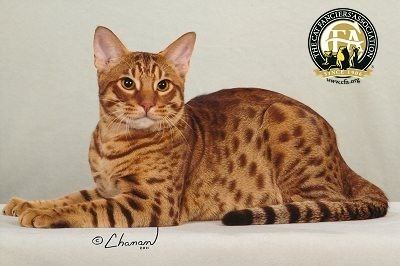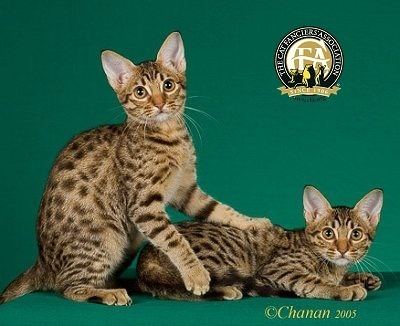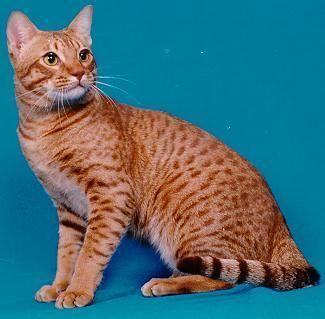CFA standard TICA standard ACFA/CAA standard Scientific name Felis catus Higher classification Cat | FIFe standard AACE standard CCA-AFC standard Origin United States of America Rank Breed | |
 | ||
Similar Egyptian Mau, Japanese Bobtail, American Curl, Balinese cat, American Bobtail | ||
Ocicat pet profile bondi vet
The Ocicat is an all-domestic breed of cat which resembles a wild cat but has no wild DNA in its gene pool. The breed is unusual in that it is spotted like a wild cat but has the temperament of a domestic animal. It is named for its resemblance to the Ocelot. The breed was established from Siamese and Abyssinian stock; later, American Shorthairs (silver tabbies) were added to the mix and gave the breed their silver color, bone structure and distinct markings.
Contents

History

The first breeder of Ocicats was Virginia Daly, of Berkley, Michigan, who attempted to breed an Abyssinian-pointed Siamese in 1964. The first generation of kittens appeared Abyssinian, but the result in the second generation was not only the Abyssinian-pointed Siamese, but a spotted kitten, Tonga, nicknamed an 'ocicat' by the breeder's daughter. Tonga was neutered and sold as a pet, but further breedings of his parents produced more spotted kittens, and became the basis of a separate Ocicat breeding program. Other breeders joined in and used the same recipe, Siamese to Abyssinian, and offspring to Siamese. In addition, due to an error by CFA in recording the cross that produced the Ocicat, the American Shorthair was introduced to the Ocicat giving the breed larger boning and adding silver to the 6 colors. The Ocicat was initially accepted for registration in The Cat Fanciers' Association, Inc., and was moved into Championship for showing in 1987. Other registries followed. Today the Ocicat is found all around the world, popular for its all-domestic temperament but wild appearance. The Ocicat was named by Virginia's daughter, Virginia E. Daly.
Appearance

There are twelve colors approved by most registries, including The Cat Fanciers' Association, Inc. standard for the Ocicat breed. Tawny, chocolate and cinnamon, their dilutes, blue, lavender and fawn, and all of them with silver: black silver (ebony silver), chocolate silver, cinnamon silver, blue silver, lavender silver and fawn silver. Ocicats have almond shaped eyes. They also have large, strong bodies, muscular legs with dark markings, and powerful, oval shaped paws. Their heads can be described as having a "wedge" shape that is longer than wide. Their ears are tilted at a 45 degree angle. One of the most striking things about these cats is the dark contrasting spots. The body shape of the Ocicat is partway between the svelte Oriental and the sturdy American Shorthair. The breed's large, well-muscled body gives an impression of power and strength, and is greater in weight than expected by appearance.
Temperament
Ocicats are friendly and sociable and are not often shy around strangers. This makes them good family pets, and most can also get along well with animals of other species. Their temperament is similar to that of a dog and are often referred to as a "dog in a cat's body". Most can be trained to fetch, walk on a leash and harness, come when called, speak, sit, lie down on command and other dog-related tricks. Some even take readily to water. Most are especially good at feline agility because they are very toy-driven. These attributes make the ocicat a domestic cat that requires more attention from their owners.


